You’ll achieve superior detail quality when printing miniatures separately, as individual components can be optimized with tailored settings for maximum precision. This approach reduces material waste by up to 60% since you’re only reprinting failed parts rather than entire models. You’ll gain unprecedented customization freedom, mixing and matching components while eliminating support material requirements that often damage delicate features. Separate printing also minimizes cascade failures and allows precision-focused painting processes. Continue exploring to discover advanced techniques that’ll transform your miniature collection.
Enhanced Detail Quality Through Focused Printing
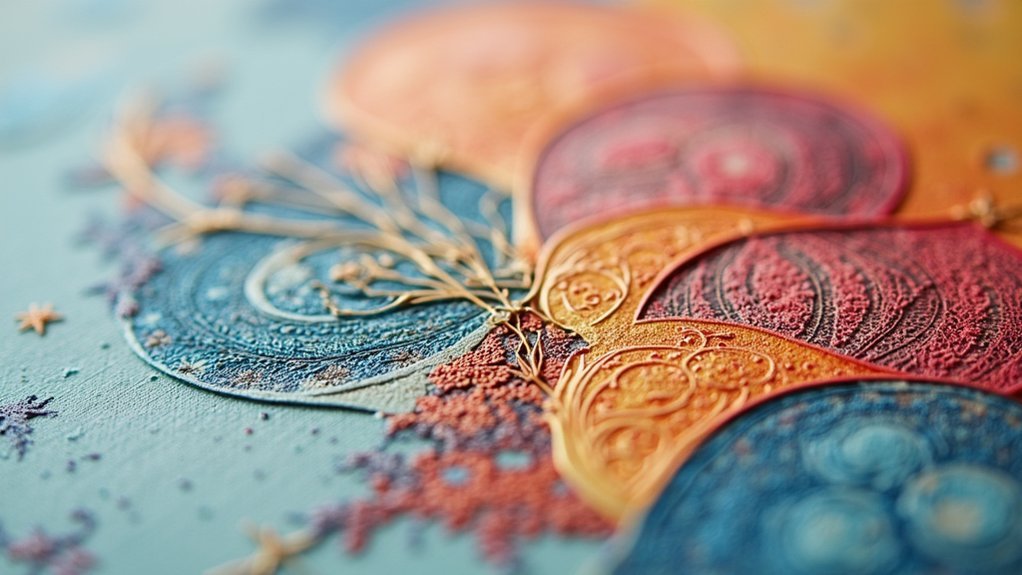
When you separate miniature printing from larger models, you’ll immediately notice the dramatic improvement in detail quality that focused printing delivers.
The dedicated printing process guarantees intricate designs and fine features reproduce accurately without quality loss. You’ll achieve enhanced detail quality through SLA/DLP printers that use light to cure resin, providing superior precision compared to filament-based alternatives.
SLA/DLP resin printing delivers unmatched precision for miniatures, ensuring every intricate detail reproduces flawlessly without compromise.
High resolution settings enable complex geometries and fine details that traditional manufacturing methods can’t match. Your miniatures will show fewer layer lines and artifacts that typically affect larger prints.
Facial expressions, detailed textures, and complex architectural elements emerge with stunning clarity. This focused approach lets you create models with exceptional craftsmanship that’s perfect for painting and display, transforming your hobby projects into professional-quality pieces.
Reduced Support Material Requirements
By printing miniatures separately, you’ll dramatically reduce support material requirements and minimize the complex scaffolding that typically clutters larger prints.
This optimization allows you to design each component with minimal support needs, greatly cutting your printing costs since you’ll consume less resin or filament per project.
When you eliminate excessive supports, you’re protecting the quality and integrity of your miniatures during the removal process. Detailed features like facial expressions, weapon engravings, and armor textures remain pristine without support-induced damage.
You’ll also maximize your build volume efficiency, fitting more miniatures per print cycle. This streamlined approach shortens printing time while delivering cleaner, more aesthetically appealing results that showcase your miniatures’ intricate craftsmanship without unsightly support marks.
Improved Print Success Rates for Complex Designs
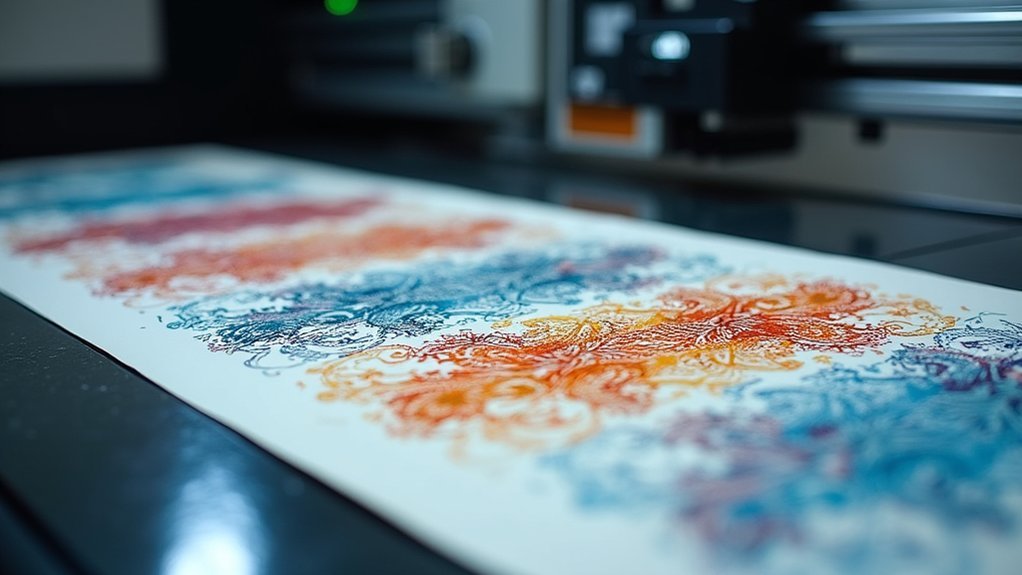
Complex miniature designs present numerous failure points that you can effectively eliminate through separate printing strategies.
When you break down intricate models into individual components, you’re dramatically improving your success rates by reducing the chances of catastrophic failures affecting entire builds. Each piece can be optimized independently, allowing you to fine-tune critical parameters like layer height and print speed for maximum quality.
Separate printing enables you to identify and correct issues before they compromise your whole project. If one component fails, you’ll only need to reprint that specific part rather than starting over completely.
This modular approach transforms complex designs from risky endeavors into manageable projects with predictable outcomes, ensuring consistent print quality across every element.
Cost-Effective Material Usage and Waste Reduction
When you print miniatures separately, you’ll consume material with surgical precision rather than wasting it on failed batch prints.
You’re eliminating the costly cascade effect where one ruined model forces you to restart an entire multi-piece job, dramatically cutting your production waste.
This targeted approach translates into real long-term savings since you’re only using filament or resin for successful prints rather than throwing away expensive materials from botched runs.
Precise Material Consumption
Since additive manufacturing only deposits material where it’s actually needed, 3D printing miniatures delivers exceptional material efficiency that traditional manufacturing methods can’t match. You’ll experience precise material consumption that eliminates the wasteful cutting and carving associated with subtractive techniques.
| Manufacturing Method | Material Waste | Cost Per Miniature |
|---|---|---|
| Traditional Casting | High | €0.45-0.60 |
| Subtractive Methods | Very High | €0.50-0.75 |
| 3D Printing | Minimal | €0.20 |
When you’re customizing designs for specific projects, 3D printing guarantees you only produce what’s necessary. This targeted approach helps reduce excess waste while maximizing your material investment. You’ll find that each filament strand or resin drop contributes directly to your finished miniature, creating an incredibly efficient production process that saves both money and materials.
Minimized Production Waste
Beyond efficient material consumption, 3D printing miniatures virtually eliminates production waste through its additive manufacturing approach.
You’ll discover that this process only deposits material where it’s actually needed, contrasting sharply with traditional subtractive methods that carve away excess material. When you embrace additive manufacturing, you’re choosing a method that builds your miniatures layer by layer, ensuring every bit of material serves a purpose.
Your minimized production waste extends beyond the printing process itself. On-demand printing means you won’t maintain large inventories that might become obsolete or damaged.
You’re also working with materials like PLA that are biodegradable, reducing your environmental footprint. This efficient approach saves you approximately €0.20 per miniature while supporting sustainable manufacturing practices.
Long-Term Savings
While the immediate cost savings of €0.20 per miniature might seem modest, you’ll realize substantial long-term savings that compound over time.
Regular 3D printing transforms your initial printer investment into ongoing financial benefits as material costs remain consistently low compared to purchasing pre-manufactured miniatures.
You’ll reduce excess inventory costs by producing miniatures on-demand, eliminating the financial burden of unsold products sitting on shelves.
This precise material usage means you’re only spending money on what you actually need and use.
For avid gamers and collectors, these cumulative savings become significant.
The ability to create multiple copies simultaneously maximizes your resource efficiency during each printing session, further lowering per-unit costs while building your collection affordably.
Greater Customization Options for Individual Components
When you print miniature components separately, you’ll release unprecedented design freedom for each individual piece.
You can craft unique poses, expressions, and accessories that perfectly match your vision rather than settling for generic mass-produced options.
This approach lets you mix and match parts from different designs, creating virtually limitless combinations that make your miniatures truly one-of-a-kind.
Individual Component Design
Individual component design represents one of the most compelling advantages of separate miniature printing, offering you unprecedented control over every aspect of your creations.
This approach lets you craft each piece with intricate details and complex geometries that traditional mass-produced miniatures simply can’t achieve.
You’ll find that customization extends far beyond basic modifications. You can adjust scale, proportions, and thematic elements to match your specific vision perfectly.
When you need to refine a particular component, you can modify and test individual designs through rapid prototyping without disrupting your entire model.
The flexibility also allows you to integrate different materials and finishes across components, creating unique aesthetic combinations that enhance both visual appeal and functionality for your gaming scenarios.
Mix and Match Parts
Because separate printing releases true modularity, you can build an entire library of interchangeable components that transforms how you approach miniature creation.
You’ll develop an arsenal of weapons, armor pieces, and accessories that work across multiple figures. This mix and match parts system lets you swap a warrior’s sword for a mage’s staff or change heavy armor for lightweight gear instantly.
Your customization options expand exponentially as each new component multiplies possibilities across your existing collection. You’re not locked into predetermined configurations anymore.
Instead, you can adapt miniatures for specific scenarios, campaigns, or aesthetic preferences. The separate printing process guarantees high-quality finishes on individual pieces while maximizing versatility in your gaming experience.
Every component becomes a building block for countless unique combinations.
Simplified Painting and Finishing Processes
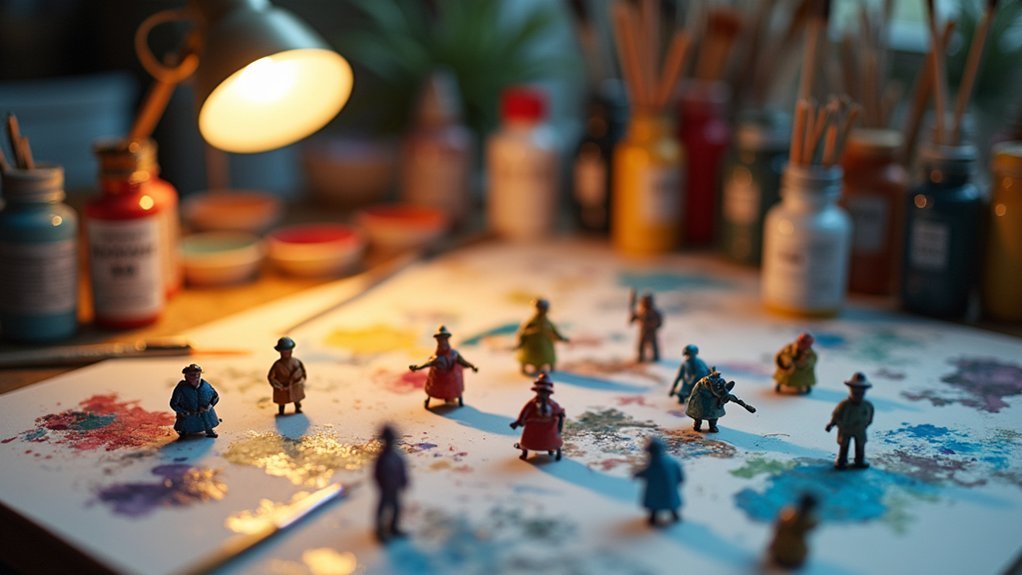
While traditional one-piece miniatures force you to maneuver around complex geometries and risk damaging adjacent details, separate component printing transforms your painting workflow into a precision-focused process.
You’ll find simplified painting becomes achievable when working with individual parts, eliminating overspray concerns and allowing independent color application. The modular nature lets you focus intensely on one component at a time, achieving meticulous detailing that’s impossible with assembled models.
Post-processing steps like sanding and priming become considerably more manageable when you’re handling separate pieces rather than maneuvering complex assembled geometries.
You’ll achieve cleaner finishes with less effort. Additionally, this approach creates durable miniatures that support long-term maintenance. When specific components need touch-ups or repairs, you can address them individually without risking damage to surrounding painted areas, preserving your investment.
Easy Replacement of Damaged or Lost Parts
When you break or lose a miniature part, you don’t need to buy an entire new figure or wait weeks for manufacturer replacements.
You can simply print the exact component you need for around €0.20 in materials, getting back to your hobby immediately.
This on-demand approach saves you money and eliminates the frustration of sourcing hard-to-find parts from retailers.
Cost-Effective Part Replacement
As anyone who’s worked with miniatures knows, broken arms, lost weapons, and damaged accessories are inevitable parts of the hobby.
Instead of buying entire new models or complete sets, you can greatly reduce costs by printing individual replacement parts. At approximately €0.20 per piece, 3D printing offers exceptional value compared to purchasing new miniatures that often cost considerably more.
Print on demand capabilities mean you’ll never wait for shipping or worry about stock availability. You can produce exactly what you need, when you need it.
Beyond basic replacement, customization options let you modify parts to better suit your preferences or improve upon original designs. Online repositories provide countless design options, making cost-effective replacement even more accessible for your miniature projects.
Immediate On-Demand Printing
Beyond the cost savings, 3D printing transforms how quickly you can get back to your hobby after mishaps occur. Immediate on-demand printing lets you replace damaged parts within hours instead of waiting days or weeks for traditional shipping methods.
You’ll eliminate downtime by producing exactly what you need when accidents happen to your miniatures.
The flexibility of 3D printing guarantees you can customize replacement parts to match your original specifications perfectly, maintaining collection consistency.
You won’t need extensive inventories since you’re printing only what’s necessary, saving storage space and costs. Additionally, you can enhance designs during replacement, incorporating improvements or updates.
This on-demand approach keeps your gaming and modeling activities flowing smoothly without lengthy interruptions from damaged or lost components.
Better Storage and Organization Solutions
Since you’re printing miniatures individually, you’ll discover that creating customized storage solutions becomes remarkably straightforward.
You can create objects specifically designed for your miniature sizes and shapes, maximizing space efficiency while maintaining better quality organization systems.
These individualized containers and racks keep your miniatures easily accessible while reducing damage risks during storage.
You’ll prevent clutter and enhance your collection’s aesthetic appeal by designing storage that complements your miniatures perfectly.
Custom storage incorporates useful features like labels and compartments, helping you sort miniatures by type or usage.
This efficient organization saves valuable time during gameplay and painting sessions, since you can quickly locate and retrieve exactly what you need without searching through disorganized collections.
Mix and Match Compatibility Across Different Models
When you print miniatures separately, you release the freedom to interchange parts between different models, creating truly personalized figures that reflect your unique vision.
This mix and match compatibility transforms how you approach miniature collecting, offering unprecedented customization possibilities that weren’t available with traditional single-piece models.
You’ll discover three key advantages with this approach:
- Creative Expression – You can combine weapons, armor, and accessories from various designs to craft one-of-a-kind characters.
- Cost Efficiency – Print only the specific components you need rather than purchasing entire new models.
- Easy Upgrades – Modify existing miniatures with new parts as your preferences evolve.
This flexibility dramatically reduces your overall cost while expanding creative possibilities, making miniature gaming more accessible and personalized than ever before.
Optimized Print Settings for Each Component Type
Each component type in your miniature collection demands its own tailored print settings to achieve ideal results.
When you’re printing arms separately from torsos, you’ll need different layer height configurations—finer details require thinner layers while larger components can handle thicker ones. Your choice of printing materials also influences these optimized print settings, as PLA requires different temperature calibrations than resin.
Complex geometries like weapons or intricate armor benefit from slower print speeds and strategic support placement. You can adjust exposure times specifically for delicate facial features while using faster settings for basic body parts.
Intricate miniature components demand customized print speeds and exposure settings to capture fine details while maintaining structural integrity.
This targeted approach prevents common issues like stringing or poor adhesion that occur when using universal settings. By customizing parameters for each component type, you’ll achieve superior detail quality and reduce failed prints considerably.
Reduced Risk of Print Failures Affecting Entire Models
While complete model failures can devastate hours of printing work, separating your miniature components creates a safety net that protects your entire project.
When you print pieces individually, you’ll experience reduced risk of print failures affecting your whole model. If one component fails, you’ll only need to reprint that specific piece rather than starting over completely.
Here are three key advantages of this approach:
- Isolated troubleshooting – You can identify and fix specific issues without compromising other components.
- Targeted reprints – Only failed pieces require reprinting, leading to significant material savings.
- Quality optimization – Each component can achieve improved print quality through individualized settings.
This strategy guarantees efficient use of time while minimizing wasted resources and frustration.
Enhanced Creative Freedom in Design Modifications
Since you’re printing components separately, you’ll gain unprecedented creative control over every aspect of your miniatures. The design process becomes infinitely more flexible when you can modify individual parts without affecting the entire model. Your customization options expand dramatically, allowing you to tailor each miniature to specific themes or personal preferences.
You’ll make intricate design modifications effortlessly through digital revisions, eliminating lengthy prototyping cycles. Complex geometries become achievable—internal cavities, dynamic poses, and features impossible with traditional manufacturing are now within reach. Various 3D modeling software options enable continuous iterations and enhancements.
| Traditional Constraints | Separate Printing Freedom |
|---|---|
| Fixed design limitations | Unlimited creative possibilities |
| Costly revisions | Instant digital modifications |
| Simple geometric shapes | Complex internal structures |
Frequently Asked Questions
What Are the Benefits of Multi-Material Printing?
You’ll combine different materials in single prints, creating complex geometries impossible with traditional methods. You’ll achieve varied colors, textures, and mechanical properties while producing lightweight designs that maintain structural integrity through strategic density variations.
What Were the Benefits of Printing?
You’ll enjoy cost-effective customization at €0.20 per piece, eliminate storage needs through on-demand production, achieve high-resolution details with SLA/DLP technology, and control final quality through hands-on post-processing techniques.
What Are Some Benefits of 3D Printing in Space?
You’ll reduce launch costs by manufacturing tools on-demand rather than transporting them from Earth. You can create custom repairs instantly, recycle waste materials, and build lightweight structures suited for space’s harsh conditions.
What Are the Benefits of 3D Printing Enclosure?
You’ll achieve perfect custom fits for your components while reducing material waste. You can rapidly prototype complex designs with integrated features like ventilation holes, plus you’ll save on inventory costs through on-demand production.

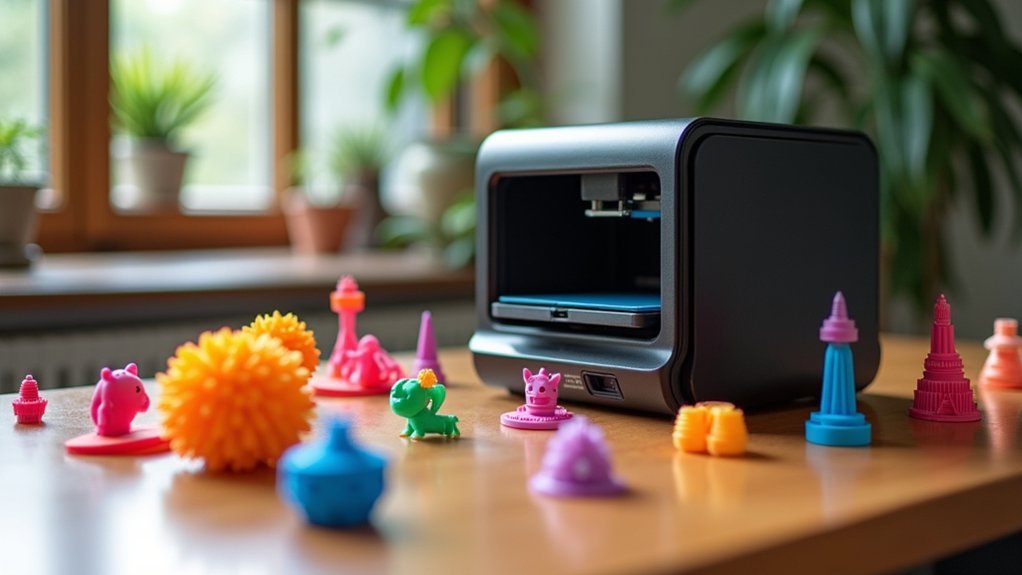
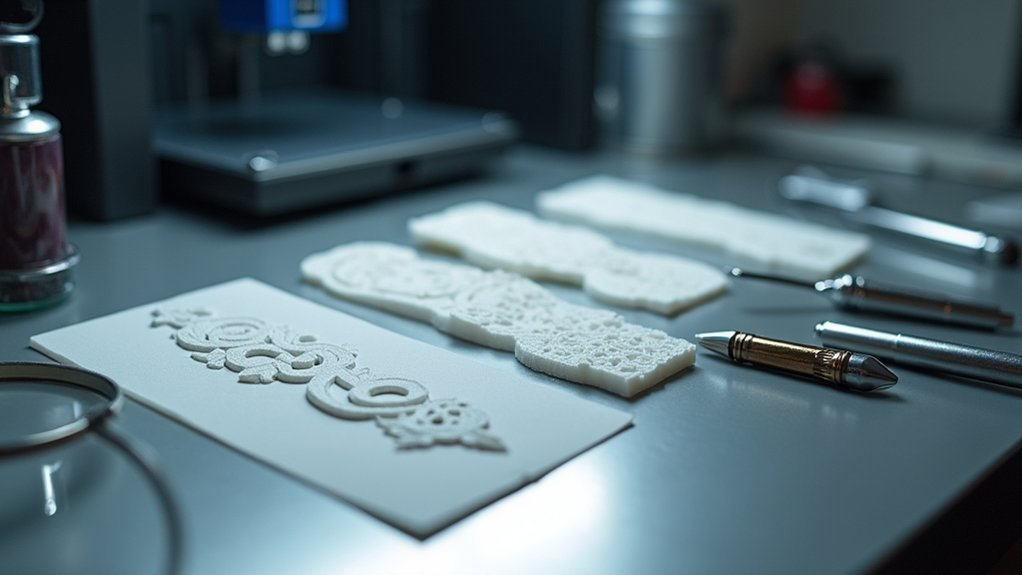
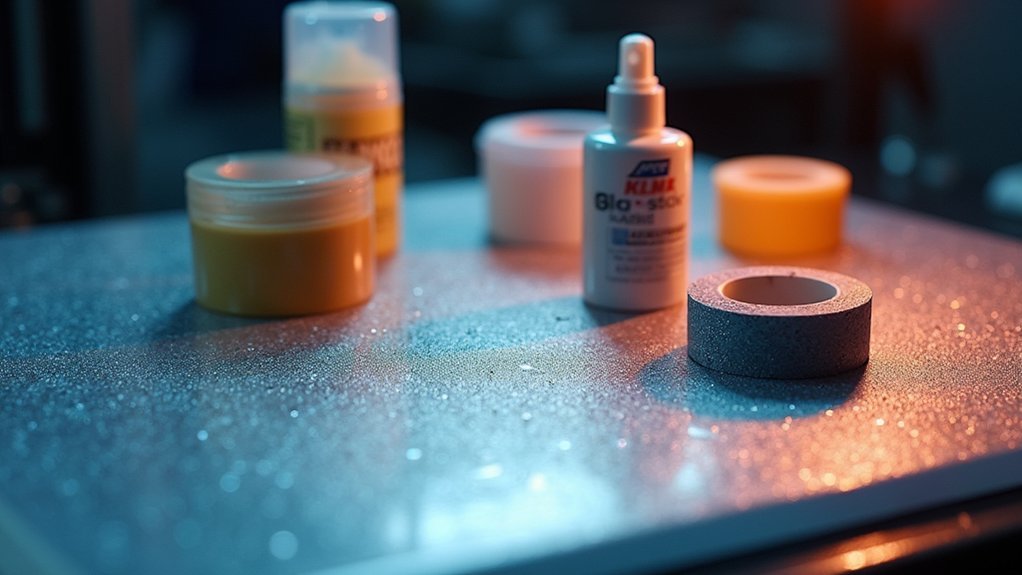
Leave a Reply